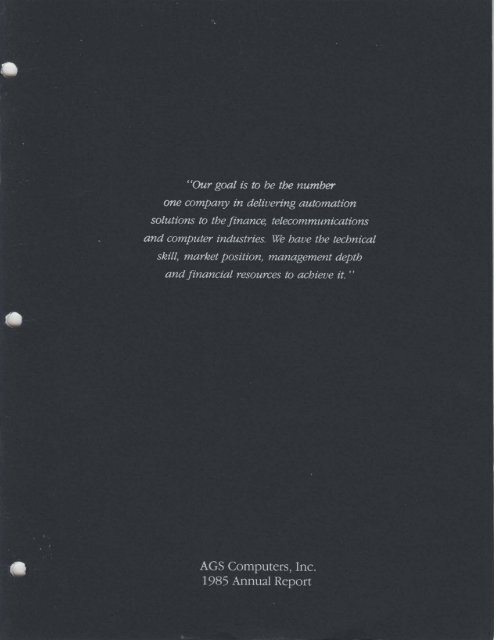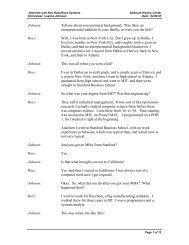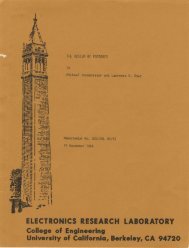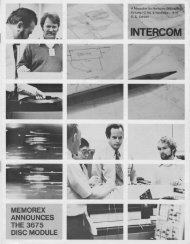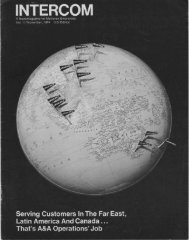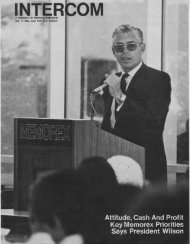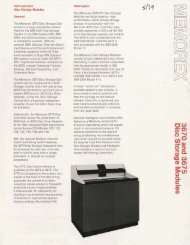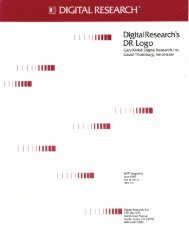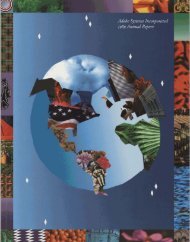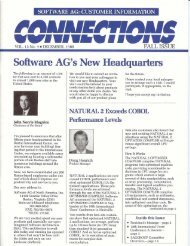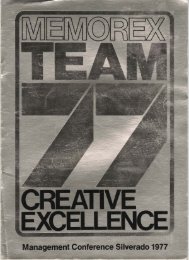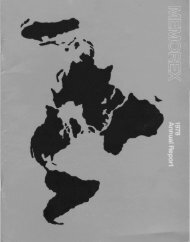AGS Computers Annual Report 1985 - the Information Technology ...
AGS Computers Annual Report 1985 - the Information Technology ...
AGS Computers Annual Report 1985 - the Information Technology ...
- No tags were found...
You also want an ePaper? Increase the reach of your titles
YUMPU automatically turns print PDFs into web optimized ePapers that Google loves.
PI\@ T ~ LOF E CONTENTSLetter To Shareholders 2SoftwareMicroconlputer DistributionFinancial SectionCORPORATE PROFILE<strong>AGS</strong> <strong>Computers</strong>, Inc. provides automation solutions to <strong>the</strong>telecommunications, finance and computer industries. Offeringcommercial systems development services, software products andmicrocomputer distribution, <strong>the</strong> company is a leader in each of<strong>the</strong> market niches in which it operates.FINANCIAL HIGHLIGHTS<strong>1985</strong> 1984 % IncreaseSales $279,182,000 $22 1,63 1,000 26.0%Net income 7,493,000 5,839,000 28.3Net income per share $1.43 $1.11 28.8
"Our growth hasbeen carried out ina careful andunderstandablemanner. We've setmeaningful goals,and have consistentlymet orexceeded <strong>the</strong>m.Simply put, we'vedone what we'vesaid we would do. 9 9TO OUR SHAREHOLDERSDear Shareholder:In <strong>1985</strong>, we achieved ano<strong>the</strong>r record year for earnings andrevenues - <strong>the</strong> seventh consecutive year in which both earningsand revenues exceeded <strong>the</strong> previous year's level.We are especially proud of our record performance during ayear that provided a number of challenges. We grew considerablyin <strong>1985</strong>, and we believe <strong>the</strong> record results show <strong>the</strong>fundamental strength of our business.Looking Forward To 1986We remain committed to being <strong>the</strong> leading company indelivering automation solutions to <strong>the</strong> telecommunications,finance and computer industries. Though we enter 1986 withsome concerns over <strong>the</strong> economic environment, we are confidentthat we are well-positioned to achieve continued success.There are several fundamental reasons for our confidence:The business we are in and <strong>the</strong> functions we perform arepart of an industry projected to grow much faster than <strong>the</strong>economy as a whole.The industries we serve are among <strong>the</strong> fastest-growing inour economy, and our clients are <strong>the</strong> premier companieswithin those industries.We have built leadership positions in <strong>the</strong> markets we serve,while our overall market share is small enough to permitsubstantial opportunities for growth.We have a strong management team, and <strong>the</strong> capital tofinance our continued growth.In <strong>the</strong> coming year, we plan to continue our focused acquisitionprogram. Since 1978, we have consistently pursued complementaryacquisitions that move us towards our goal ofproviding truly comprehensive automation solutions.Two acquisitions made after year-end illustrate <strong>the</strong> pattern, we continue to follow:Through Microamerica, our microcomputer distributionsubsidiary, we have agreed to acquire Compuserve, Canada's
largest distributor of microcomputer products. The combinedentity will broaden Microamerica's market leadership, and willalso provide <strong>the</strong> foundation for expansion into o<strong>the</strong>r internationalmarkets.We have also agreed to purchase Genasys Corporation, asystems development company that serves <strong>the</strong> Federal governmentmarket. This will give us efficient and timely access to anew market for our systems development services. T~IS marketis estimated to be almost as large as <strong>the</strong> commercial marketswe already serve.Some <strong>1985</strong> AccomplishentsIn <strong>1985</strong>, Microamerica maintainedand extended its positionas <strong>the</strong> nation's preeminent distrib-Iutor of microcomputer relatedproducts. Named by a respectedcomputer publication as <strong>the</strong>number one company in itsfield, it continued to demonstrateits special managementstrengths by posting large profitgains during a year that provedextremely difficult for most ofits competitors. The acquisitionof Compuserve will enable our distribution subsidiaries tobecome an even more important resource to microcomputersuppliers faced with delivering a flood of new products to ahighly fragmented market.During <strong>1985</strong>, we continued to build our systems developmentskills, while broadening <strong>the</strong> range of services we provideto a growing array of clients. At <strong>the</strong> same time, we developedsome promising sofhare products as an outgrowth of ours ys tems development work.One such product is a Risk Asset Management System(RAMS) developed by our Software Design Associates subsidiaryLawence J. S c h m (lr)Chairman,Chief Ex-ecutive OfficerJoseph A brmPresident,chief Operating Officer
Currently in use by two major New York banks, RAMS is ahighly integrated on-line database management system thatallows immediate access to information about <strong>the</strong> risk exposuresof bank portfolios.Our software products offer a number of opportunities forus to gain leverage from our technical skills and from ourbroad applications experience in systems development. Wewill discuss fur<strong>the</strong>r <strong>the</strong> connections between our softwareproducts and our systems development services within <strong>the</strong>annual report's narrative section.During <strong>the</strong> year, we maintained and expanded our relationshipswith key clients such as AT&T and IBM, as well as witho<strong>the</strong>r large computer companies and major fmcial institutions.W continued to broaden our corporate presence by openingfive new offices in <strong>1985</strong>. We also substantially expanded<strong>the</strong> aeative staff within our corporate oftices and within ouropting corn*. Both steps represent an investment inour ability to conthue ppving profitablyOur sales passed $279 million in <strong>1985</strong>, with more than $117million coming from software and systems development, and$161 mWon from microcomputer distribution. Sales grew $58million last year - an amount that by itself places us among<strong>the</strong> largest companies in <strong>the</strong> computer services industry.As we have grown to our present size, we have createdleadership positions in all <strong>the</strong> markets we serve. We continueto find that many of our corporate skills are transferable within ,each market, allowing us to provide a wider range of servicesand products to each of <strong>the</strong>m.Our size often serves as a distinct advantage when we arecompeting for large projects. Our market position also insulatesus somewhat from market forces that might affect moreseverely some competitors who occupy a secondary position... -J.n addition, our participation in several different markets providesa measure of protection from forces at work in any oneof <strong>the</strong> individual markets - a kind of portfolio effect which
has proven to be helpful in maintaining our pattern of consistentgrowth.Looking At Our RecordOur operating results reflect a pattern of rapid and consistentgrowth. Over <strong>the</strong> past five years, net profits have grown ata 67% annual rate, and in <strong>1985</strong>, our return on shareholders'equity was 36% pre-tax.Perhaps most important, our growth has been carried out ina careful and understandable manner. We have set meaningfulgoals, and have consistently met or exceeded <strong>the</strong>m. Simplyput, we've done what we've said we would do.We attribute our accomplishments in large measure to our2,300 skilled and enthusiastic staff members. They can all beproud of <strong>AGS</strong>'s continuing record of success, and we thank<strong>the</strong>m for <strong>the</strong>ir efforts. We also wa~t to add our thanks to ourcustomers and to our shareholders for <strong>the</strong>ir continuing support.Yours sincerely,Lawrence J. SchoenbergChairman,Chief Executive OfficerJoseph AbramsPresident,Chief Operating Officer
<strong>AGS</strong> <strong>Computers</strong> helps companies make more effective useof <strong>the</strong>ir computer systems by providing professional servicesfor systems development, as well as software products thathave been designed to suit <strong>the</strong> special needs of our clients.Our role has evolved as businesses' needs for improvedmanagement information have evolved. Our growth has beenfur<strong>the</strong>r stimulated as large companies have implemented enduserfront-office applications which inevitably require that<strong>the</strong>ir data processing solutions meet <strong>the</strong>ir specific needsmore closely. In fact, <strong>the</strong> largest companies with <strong>the</strong> mostsophisticated data processing operations are exactly <strong>the</strong> companiesthat continually require new and more advanced solutions.These large and advanced data processing users are at<strong>the</strong> heart of <strong>the</strong> key markets we serve - <strong>the</strong> telecommunications,frnance and computer industries.Our systems development work accounts for <strong>the</strong> majority ofour revenues in this $117 million sector of our business, andmakes us one of <strong>the</strong> largest professional services companies in<strong>the</strong> commercial custom-development area. The skills we bringto bear on systems development also create parallel opportunitiesin <strong>the</strong> use of our software products. In this way,<strong>AGS</strong>'s services and software products combine in a cohesiveapproach to provide an overall automation solution.Systems Development And Software Products:The InterplayWe continue to seek and develop opportunities to gainleverage from our technical expertise and broad applicationsexperience. There are many examples of this leverage in <strong>the</strong>interplay between our systems development work and <strong>the</strong>development of software products.Our special expertise in building large-scale, high-transactioninformation processing systems has led to many, long-term systems development relationships with <strong>the</strong>country's largest banks.
@Our subsidiary, Software Design Associates (SDA), developed<strong>the</strong> Risk Asset Management System, described earlier, for <strong>the</strong>banking industry as an outgrowth of its systems developmentwork. At <strong>the</strong> same time, our DISC subsidiary develops andmarkets a wide range of software for specialized financialapplications, including cash reconciliation and interest reportingprograms for banks throughout <strong>the</strong> country. In fact, twothirdsof <strong>the</strong> nation's 100 largest banks are using DISC software,which has become <strong>the</strong> banking industry standard.Opportunities develop inmany ways. Sometimes softwareproducts evolve from our consultingactivities, but more often,consulting activities evolve1through <strong>the</strong> sale of software.Our subsidiary, <strong>AGS</strong> ManagementSystems, sells softwareproducts that help companiesmanage large projects and control<strong>the</strong> systems developmentprocess. The products aresimply <strong>the</strong> most advanced in<strong>the</strong>ir field.One such product, <strong>the</strong>ir SysternsDevelopment Methodology (SDM), has been purchased byCoopers & Lybrand, one of <strong>the</strong> world's largest public accountingand consulting organizations. Coopers & Lybrand will useSDM to standardize <strong>the</strong>ir approach to managing systemsdevelopment projects for <strong>the</strong>ir many consulting clients.This sale of software will create a number of new systemsdevelopment and consulting opportunities for us. As <strong>the</strong>Coopers & Lybrand professionals use our methodology at <strong>the</strong>irvarious clients, we anticipate obtaining substantial new businesscontracts from those clients.
Leverage From Our Technical SkillsOur long-term involvement in <strong>the</strong> telecommunications andcomputer industries has provided us with many opportunities tosupply high-level professional services in systems development.We have long-standing relationships with <strong>the</strong> AT&T companies,and are well-known for our expertise in UNIX-basedsystems. As we continue to provide systems development servicesto <strong>the</strong> AT&T companies, we have been asked to evaluateand manage <strong>the</strong> transfer of o<strong>the</strong>r companies' software to AT&Tcomputer equipment. We havealso consulted for o<strong>the</strong>r computerand peripheral equipmentmanufacturers to ensure <strong>the</strong> correctapproach in connecting <strong>the</strong>irequipment to AT&T equipment.Leverage from our UNIX-basedsystems expertise goes beyond<strong>the</strong> telecommunications andcomputer industries, extending 4into <strong>the</strong> commercial sphere offinancial services as well. We havedeveloped a unique bond tradingsystem for Bear Stearns & Co., amajor Wall Street firm. Operatingunder UNIX, on AT&T hardware, this system tracks all transactionsin <strong>the</strong> government bond area, giving access to currentsecurity positions and client exposure information. It representsa special opportunity for us to work across <strong>the</strong> lines of our specialmarkets, and demonstrates <strong>the</strong> benefits of our well-focusedtechnical expertise and market specialization.Our unmatched technical skills in <strong>the</strong> area of computer communicationssoftw;are occupy a position of growing importance.An emerging range of hardware devices, like bank and4., ~etail terminals, are being connected by communications lines,even though <strong>the</strong>y were nei<strong>the</strong>r conceived nor designed to do so.4
Thus, it becomes more and more vital for different kinds ofcomputer equipment to work toge<strong>the</strong>r effectivelyOur Systems Strategies subsidiary is <strong>the</strong> leading supplier ofcommunications software designed to allow non-IBM mini andmicrocomputer systems to communicate effectively with IBMmainframes, By permitting small systems to communicate andoperate just as if <strong>the</strong>y were remote IBM terminals, our softwareallows our clients, who include <strong>the</strong> major computer and peripheralmanufacturers, to efficiently tie <strong>the</strong>ir systems to IBM systems.Even in this area, <strong>the</strong>re is a technical benefit that crosses overbetween our software products and our systems developmentskills. All our cornmications software operates under UNIX,giving us fur<strong>the</strong>r leverage in develophg and adapting applicationsthroughout our business.?Be Conmcthn Betweem Wr SkillsIn most cases, <strong>the</strong> decisions to use our comulmg servicesand our software products are made indcpmbtly. But <strong>the</strong>connections between our services and our products wne toillustrate <strong>the</strong> emerging breadth of our approach to providingcomplete automation solutions in our selected niche markets.The connection also adds a kind of marketing lmemge to <strong>the</strong>powerful technical leverage we enjoy.Additionally, whe<strong>the</strong>r we offer software products ar systemsdevelopment services, many of <strong>the</strong> skills remain similar. Thesame kinds of technical competence, analytical ability and consultativeskills that so distinguish us in <strong>the</strong> professional servicesarea, also serve us well in <strong>the</strong> software products business.Armed with widely-recogwed technical skills, and leadershippositions in a number of exciting areas, we we well on ourway to becoming <strong>the</strong> number one company in deliveringautomation solutions to <strong>the</strong> iinmce, ~~ecommunications andcomputer industries. Tk believe <strong>the</strong>se arm promise us anexciting and rewarding funue.' 'Last year wecontinued to gainleverage from ourtechnical expertise,our market positionand our broadapplicationsexperience. ? ?
MICROCOMPUTER DISTRIBUTIONOur Microamerica subsidiary is <strong>the</strong> largest distributor ofmicrocomputer related hardware in <strong>the</strong> United States, servingsystems integrators, value-added resellers, computer retailersand consultants throughout <strong>the</strong> country,Operating just over six years, <strong>the</strong> company has grown to bepreeminent in its field. While Microamerica is <strong>the</strong> largestmicrocomputer distributor in <strong>the</strong> country, <strong>the</strong> company'simportance as an industry leader goes far beyond size.By providing a unique and innovative program of training,support and service to its customers, Microamerica has become afull-service resource, and not just ano<strong>the</strong>r intermediary in <strong>the</strong> distributionbusiness. In a period when microcomputer distributorshave seen competition severely erode profit margins,Microamerica has set new sales and profit records year after year.This is entirely due to a superb management team that isunmatched in its marketing skills and organizational abilityWhat Makes Microumwica Special?Microamerica has set itself apart in a number of ways. First isits creation of a series of innovative services that were industryfasts. They include:&e M~tty's first comprehensive inventorytkambxg pzqpm br ckders.TIPS, a unique 'I&Wcal <strong>Information</strong> and Product SupportCIservice to answer deaiers' technical questions.MicraScbo01~ an extensive curriculum of sales and productrelatedtrahing courses for dealers.MicroPromotions, an innovative series of promotional andadvertising programs designed to stimulate dealer sales.In addition to <strong>the</strong>se programs, Microamerica offers incentiveplans, co-op advertising, lead referrals and a broad range ofo<strong>the</strong>r suppart services designed to mure dealer success and5 main- dealer loyaltyThe company sells only to resellem, and never to end-users.This prevents <strong>the</strong> appearance of competition, and is designed
to show dealers that <strong>the</strong>y have a distributor who has THEIRlong-term success in mind. Gordon Hoffstein, Microamerica'sPresident, says:"We've always tried to put ourselves in our dealers' shoes.More than any o<strong>the</strong>r factor, this seems to explain our recordof unparalleled dealer support, and our resulting success in<strong>the</strong> marketplace.' 'Relationships With Suppliers: A Strategic ApproachThere's ano<strong>the</strong>r side to Microamerica's success - its formationof important continuingrelationships with its suppliers.Microamerica calls <strong>the</strong> relationships"strategic alliances." Theserelationships extend far beyondsimply being an approved distributorof a given product line.Microamerica becomes, ineffect, an extension of <strong>the</strong> manufacturers'sales and marketingorganizations - a resource inIbringing products to market.Supplying promo tion, technicalsupport, product information Iand publications, Microamericaprovides a means of accomplishing certain functions thatmanufkcturers might o<strong>the</strong>rwise have to provide <strong>the</strong>mselves.In fulfilling its broad-based role, Microamerica works with itskey suppliers on <strong>the</strong>ir marketing plans, product positioning,support and training. This gives <strong>the</strong> manufacturers marketingleverage that is not o<strong>the</strong>rwise available. These close workingrelationships have led Microamerica to limit itself to a smallnumber of key suppliers. This is in sharp contrast to <strong>the</strong> hundredsthat more typical distributors might represent, and& emphasizes <strong>the</strong> special qualities of <strong>the</strong> Microamerica approach.@
' 'Microamerica hasgrown to be preeminentin its field.It's not just <strong>the</strong> largestmicrocomputerdistributor in <strong>the</strong>country, it's also <strong>the</strong>most important. "A Special Sense Of The MarketMicroarnerica couldn't have grown so large so quicklywithout being extremely sensitive to developments in <strong>the</strong>markets for microcomputers and related equipment.The company's nationally-recognized expertise in productevaluation and selection has helped in selecting <strong>the</strong> keymanufacturers with whom Microamerica has formed its"strategic alliances." From <strong>the</strong> outset, it has helped to avoidcostly inventory problems by leading <strong>the</strong> company away frompotential problem products.Just as important, <strong>the</strong> company's special sense of <strong>the</strong> markethas extended its critical role as an advisor to both rnanufacturersand resellers.It is this blending of strengths and integrating of services toBOTH dealers and manuf5cwrs that explains Microamerica'ssuccess. It re- a continuing source of promise for <strong>the</strong>future, reflecting mast directly on <strong>the</strong> company's managementtea^ and <strong>the</strong> unique abilities <strong>the</strong>y bring to <strong>the</strong> developmentof a truly outstanding campany within <strong>the</strong> <strong>AGS</strong> family ofIcompmies.
FINANCIAL SECTION<strong>AGS</strong> <strong>Computers</strong>, Inc. and SubsidiariesFiscal <strong>1985</strong>Consolidated Statements of IncomeConsolidated Balance SheetsConsolidated Statements of Changesin Cash PositionConsolidated Statements of Stockholders' EquityNotes to <strong>the</strong> Consolidated Financial Statements<strong>Report</strong> of Independent Certified PublicAccountantsManagement's Discussion and Analysis of Resultsof Operations and Financial ConditionSelected Financial <strong>Information</strong>Price Range of Common Stock
<strong>AGS</strong> <strong>Computers</strong>, Inc. and SubsidiariesCONSOLIDATED STATEMENTS OF INCOMEFor <strong>the</strong> years ended December 31,Sales:SoftwareMicrocomputer distributionInterest incomeCost of sales:SoftwareMicrocomputer distributionSelling, general and administrative expensesInterest expenseIncome from continuing operations beforeincome taxesIncome taxesIncome from continuing operationsDiscontinued operations:Loss from discontinued operations (less applicableincome taxes of $417,000)Loss on disposal of discontinued operations(less applicable income taxes of $391,000)Loss from discontinued operationsNet incomeIncome per share from continuing operations:PrimaryFully diluted(Loss) per share from discontinued operations:PrimaryNet income per share:PrimaryFully dilutedWeighted average shares outstanding:PrimaryFully dilutedSee accompanying notes to consolidated financial statements
<strong>AGS</strong> <strong>Computers</strong>, Inc. and SubsidiariesCONSOLIDATED BALANCE SHEETSDecember 3 1AssetsCurrent assets:Cash and temporary investmentsAccounts receivable-trade, less allowances of$1,010,000 and $720,000InventoriesPrepaid expenses and o<strong>the</strong>r assetsTotal current assetsFixed assetsSoftware productsCosts in excess of net assets of subsidiaries acquiredO<strong>the</strong>r assetsLiabilities and Stockholders' EquityCurrent liabilities:Notes payableCurrent maturities of long-term debtAccounts payable and accrued liabilitiesDeferred incomeIncome taxes payableDeferred income taxes payableTotal current liabilitiesDeferred income taxesLong-term debt, less current maturitiesO<strong>the</strong>r liabilitiesTotal liabilitiesStockholders' equity:Common stock, par value $ .10 per share:authorized 25,000,000 shares in <strong>1985</strong> and 1984;issued 5,3 1 1,000 and 5,283,000Paid-in capitalRetained earningsLess 54,000 shares of treasury stock, at costTotal stockholders ' equitySee accompanying notes to consolidated financial statements.
<strong>AGS</strong> <strong>Computers</strong>, Inc. and SubsidiariesCONSOLIDATED STATEMENTS OF CHANGES IN CASH POSITIONFor <strong>the</strong> years ended December 31, <strong>1985</strong> 1984 1983Sources of cash:From continuing operations:Income $ 7,493,000 $ 6,781,000 $ 5,785,000Equity in losses of affiliated companies 338,000 365,000Depreciation and amortization 2,420,000 1,912,000 1,322,000Changes in balance sheet accounts:Income taxes payable-net 2,320,000 4,731,000 1,844,000Accounts receivable (9,004,000) (1,509,000) (7,367,000)Prepaid expenses (765,000) (167,000) (881,000)Accounts payable and accrued expenses 5,875,000 3,201,000 1,886,000Deferred income 637,000 720,000 (1,416,000)9,314,000 16,034,000 1,173,000From discontinued operations:(Loss)Depreciation and amortizationChanges in balance sheet accounts:Income taxes payable-netPrepaid expensesTotal from operationsSale of common stockCommon stock issued on conversion of debenturesCommon stock issued upon acquisition ofsubsidiaries and equity interestsCommon stock issued under employee stockownership and stock purchase plansStock options exercisedTax benefit from <strong>the</strong> issuance of stockoptionsIncrease in long-term debtDecrease (increase) in o<strong>the</strong>r assetsTotal sources of cashUses of cash:Acquisition of subsidiaries and equity interestsDecrease (increase) in notes payablePayment of long-term debtAdditions to fixed assets, netIncrease in inventoriesAdditions to software products-netDecrease in o<strong>the</strong>r liabilitiesPurchase of treasury stockTotal uses of cashIncrease (decrease) in cash and temporary investments $ 172,000 $ (1,516,000) $ (2,571,000)See accompanying notes to consolidated financial statements.
<strong>AGS</strong> <strong>Computers</strong>, Inc. and SubsidiariesCONSOLIDATED STATEMENTS OF STOCKHOLDERS' EQUITYFor <strong>the</strong> years ended December 31, 1983, 1984, and <strong>1985</strong>Common StockTreasury StockPaid-in RetainedShares Amount Capital Earnings Shares CostBalance, December 31, 1982 3,646,000 $364,000 $ 2,848,000 $ 6,847,000 690Net income 5,785,000Common stock sold 575,000 58,000 8,036,000Common stock issued 127,000 13,000 2,479,000Stock options exercised 19,000 2,000 118,000Common stock issued upon(690)conversion of debentures 855,000 85,000 8,587,000Balance, December 31, 1983 5,222,000 522,000 22,068,000 12,632,000Net income 5,839,000Common stock issued 39,000 4,000 580,000Stock options exercised 13,000 1,000 91,000Common stock issued underemployee ownership plan 6,000 1,000 123,000Common stock issued underemployee stock purchaseplan 3,000 28,000Tax benefit from <strong>the</strong> issuanceof stock options 128,000Balance, December 31, 1984 5,283,000 528,000 23,018,000 18,471,000Net income 7,493,000Treasury stock acquired 62,000 $970,000Stock options exercised 15,000 , 2,000 133,000Common stock issued underemployee ownership plan 13,000 1,000 198,000Common stock issued underemployee stock purchaseplan (2,000) (8,000) (130,000)See accompanying notes to consolidated financial statements.
<strong>AGS</strong> <strong>Computers</strong>, Inc. and SubsidiariesNOTES TO THE CONSOLIDATED FINANCIAL STATEMENTSNote A - Signifcant Accounting Policies:The financial statements include <strong>the</strong> accounts of <strong>the</strong> Company and its wholly-ownedsubsidiaries, after elimination of all significant intercompany accounts and transactions.Service revenues arising from time and material contracts are recognized as servicesare rendered. Revenues from sales of software packages are recognized as follows: (a)on sales made on standard terms, 90% of <strong>the</strong> sale amount is recognized when <strong>the</strong>package is in deliverable form with <strong>the</strong> balance recognized upon completion of trainingand support; (b) on sales made subject to client acceptance of <strong>the</strong> package,revenues are recognized after acceptance is received for <strong>the</strong> package and <strong>the</strong> collateraltraining and support. Revenues from maintenance contracts are recognized ratablyover <strong>the</strong> term of each contract. Microcomputer sales, costs of microcomputer sales andrelated selling expenses are recorded when delivery is made to <strong>the</strong> customer.Fixed assets are recorded at cost. Depreciation is computed principally on <strong>the</strong>straight line method based on estimated useful lives. Leasehold improvements areamortized over <strong>the</strong> life of <strong>the</strong> lease, or <strong>the</strong>ir estimated useful lives, whichever isshorter.Costs in excess of net assets acquired are being amortized over forty-year periods.Accumulated amortization aggregated $2,058,000 and $1,206,000 at December 31, <strong>1985</strong>and 1984, respectively.Inventories, consisting of microcomputer systems, peripherals and computer accessories,are stated at <strong>the</strong> lower of cost or market; cost is determined by <strong>the</strong> first-in firstout(FIFO) method.Deferred income taxes result from reporting certain revenue and expense items differentlyfor financial and tax reporting and are shown primarily as current liabilitiesalthough not payable within one year of <strong>the</strong>ir respective year-end dates. Investmentand research and development tax credits are reflected as a reduction of federal incometaxes in <strong>the</strong> year realized.Research and development costs which are charged to operations, amounted to$5,174,000 (<strong>1985</strong>), $4,413,000 (1984) and $2,753,000 (1983).In December <strong>1985</strong>, <strong>the</strong> Company adopted as of January 1, <strong>1985</strong> <strong>the</strong> capitalizationand amortization of software cost provisions of FASB 86. Costs of new products andenhancements to existing products are capitalized when technological feasibility existsand are amortized over <strong>the</strong> greater of <strong>the</strong> ratio of <strong>the</strong> product's current-to-futurerevenue stream or <strong>the</strong> straight line method over its estimated useful life which generallyapproximates five years. Costs deferred and amortized were $2,579,000 and$2,291,000 for <strong>1985</strong>, respectively. The change had an immaterial effect on <strong>the</strong> resultsof operations. Costs of software product enhancements with an established marketdeferred and amortized were $2,055,000 and $2,230,000 and $666,000 and $198,000for <strong>the</strong> years 1984 and 1983, respectively.Software products at December 3 1, <strong>1985</strong> include $4,608,000 arising from <strong>the</strong>purchase of subsidiaries and are stated net of accumulated amortization of $2,191,000.Primary net income per share is based on <strong>the</strong> weighted average number of shares ofcommon stock outstanding. Dilution resulting from stock options outstanding is notsignificant. Fully diluted net income per share assumed conversion on January 1, 1983of all convertible debentures into common stock; for this calculation net income wasincreased by <strong>the</strong> after tax interest of <strong>the</strong> debentures.Note B-Fixed Assets:December 31, <strong>1985</strong> 1984Fixed assets consist of:Furniture and equipment $ 5,252,000 $3,976,000Computer equipment 3,847,000 1,814,000Leasehold improvements 1,357,000 913,00010,456,000 6,703,000Less: accumulated depreciationand amortization
Note C-Notes Payable:Notes payable at December 3 1, 1984 are owed to former stockholders of companiesacquired.There were no short-term borrowings outstanding in <strong>1985</strong>. Short-term borrowingsaveraged (on a-month-end basis) $1,033,000 (1984) and $2,106,000 (1983) at amonthly weighted average interest rate of 11.0% and 10.8%, respectively. The maximumamount of short-term borrowings at any month-end was $12,400,000 (1984)and $5,200,000 (1983).Note D-Long-Term Debt:December 31, <strong>1985</strong> 1984Long-term debt consists of <strong>the</strong> following:Bank term note $1 9,750,000 $12,750,000Bank revolving credit note 8,500,000 4,000,000O<strong>the</strong>r 1,172,000 1,138,00019,422,000 17,888,000Less, current maturities 4,139,000 3,066,000$1 5,283,000 $14,822,000The Company's bank credit facility aggregated $24,750,000 at December 31, <strong>1985</strong>of which $9,750,000 was under <strong>the</strong> term note and 8 15,000,000 under <strong>the</strong> revolvingcredit note. The term note requires quarterly installments of principal of $750,000 tomaturity at January 31, 1989 plus interest at prime. The revolving credit note terminateson October 31, 1986, at which date all amounts <strong>the</strong>n outstanding are convertedto a Funded Term Loan payable in quarterly installments commencing onJanuary 31, 1987 with a final maturity date of October 31, 1989; interest, at <strong>the</strong> Company'schoosing, is ei<strong>the</strong>r at prime or LIBOR (plus 1-114% and o<strong>the</strong>r adjustments) toOctober 3 1, 1986 and 1 I2 % over prime and 1-314% over LIBOR <strong>the</strong>reafter. Underthis credit facility <strong>the</strong> payment of cash dividends is prohibited and requires <strong>the</strong> Companyto maintain several financial ratios, including working capital and cash flow.The agreement also requires <strong>the</strong> Company to maintain a compensating cash balanceof $500,000.Maturities of <strong>the</strong> non-current portion of long-term debt at December 31, <strong>1985</strong> areas follows:Note E-Income Taxes:The provisions for income taxes consist of <strong>the</strong> following:Years ended December 31, <strong>1985</strong> 1984 1983From continuing operations:Currently payable:Federal $2,461,000 $ 493,000 $1,73 1,000State and local 1,115,000 583,000 780,000Deferred:FederalState and local3,576,000 1,076,000 2,511,000From discontinued operations:Currently payable federalDeferred federal
The effect on deferred taxes from (i) reporting of income on <strong>the</strong> cash basis forincome tax purposes was $1,73 1,000, $1,196,000 and $1,662,000 for <strong>1985</strong>, 1984 and1983, respectively, (ii) <strong>the</strong> expensing of software product enhancements for income taxpurposes was $501,000 in <strong>1985</strong> and $659,000 in 1984, and (iii) differences in <strong>the</strong> valuationand amortization of acquired subsidiary assets was $1,001,000 in <strong>1985</strong> and$802,000 in 1984.A reconciliation of <strong>the</strong> provisions for taxes on income from continuing operations at<strong>the</strong> applicable Federal statutory income tax rate to <strong>the</strong> tax provisions as reported is asfollows:Years ended December 31, <strong>1985</strong> 1984 1983Provision computed at <strong>the</strong>Federal statutory incometax rate $6,959,000 $6,162,000 $4,968,000State and local income taxes,net of federal tax benefit 829,000 732,000 597,000Amortization of costs inexcess of net assetsacquired 376,000 326,000Research and developmentcredit (155,000) (510,000) (320,000)Investment tax credit (246,000) (136,000) (356,000)O<strong>the</strong>r (128,000) 40,000 176,000As reported $7,635,000 $6,614,000 $5,065,000Note F-Accounts Payable and Accrued Liabilities:December 31. <strong>1985</strong> 1984Accounts payable and accrued liabilities consist of:Accounts payable to vendors $20,220,000 $13,934,000Accrued payroll, vacation andbonus expenses 3,010,000 2,164,000O<strong>the</strong>r 2,086,000 2,714,000Note G-Stock Plans:During 1984, <strong>the</strong> Company increased <strong>the</strong> maximum number of options under itsincentive stock option plan ("ISOP") from 250,000 shares to 500,000 shares. Theoptions may be granted at not less than <strong>the</strong> market price of <strong>the</strong> shares at date of grantand are generally exercisable over a 10 year period. At December 31, <strong>1985</strong> optionsfor 282,865 shares were outstanding under <strong>the</strong> ISOP.At December 31, <strong>1985</strong> options for 1,500 shares remain outstanding under <strong>the</strong>Company's terminated qualified stock option plan.Certain information with respect to options granted under <strong>the</strong> above noted plansare as follows:Number of SharesYears ended December 31, <strong>1985</strong> 1984 1983Shares under option at beginningof period ($.53-$28.75 a share) 235,615 184,265 123,430Granted ($11.50-$28.75) 129,634 81,450 106,446Exercised ($.53-$20.00) (14,567) (13,047) (19,847)Cancelled ($9.75426.50) (66,317) (17,053) (25,764)Shares under option at end ofperiod (98.53-$28.75 a share) 284,365 235,615 184,265At December 3 1, <strong>1985</strong> and 1984 options for 99,3 12 and 74,416 shares, respectively,were exercisable.No charges were made to income in connection with <strong>the</strong> aforementioned stockoption plans since all options granted were at market.During 1983, <strong>the</strong> Company adopted an employee stock purchase plan (ESPP)which authorizes <strong>the</strong> granting of 250,000 shares of stock to all full-time employees of<strong>the</strong> Company and its subsidiaries at a price not less than 85% of <strong>the</strong> market value atdate of grant. Options to purchase 50,000 shares under this plan were authorized ofwhich 3,007 were issued in 1984 at $14.25 per share and 8,336 were issued in <strong>1985</strong>at $15.30 per share. No shares were issuable under this plan at December 3 1, <strong>1985</strong>.
During 1983, <strong>the</strong> Company adopted an employee stock ownership purchase planunder which all qualified employees of <strong>the</strong> Company and its subsidiaries are grantedshares of stock equal in value to .5% of <strong>the</strong>ir annual compensation. In connectionwith this plan, expenses of $291,000, $223,000 and $1 34,000 were reflected in <strong>the</strong>statements of income for <strong>the</strong> years ended December 31, <strong>1985</strong>, 1984 and 1983,respectively.Note H-Commitments:The Company is obligated under operating lease agreements, for its offices,warehouse facilities, and equipment. A number of leases require that <strong>the</strong> Companypay additional rents due to increased operating costs to <strong>the</strong> lessor. The minimumaggregate rentals payable under all operating leases at December 3 1, <strong>1985</strong> are asfollows:19861987198819891990199 1 and beyondTotal rental expense charged to income was $4,244,000 (<strong>1985</strong>), $2,961,000 (1984)and 9 1,760,000 (1983).Note I-Profit Sharing and 401K Investment Plan:The Company has profit sharing plans covering substantially all employees of <strong>the</strong>parent and certain of its subsidiaries. The annual contributions under <strong>the</strong> plans aredetermined by <strong>the</strong> Board of Directors. Profit sharing contributions are funded asaccrued. In <strong>1985</strong>, <strong>the</strong> Company and some subsidiaries amended <strong>the</strong>ir profit sharingplans to become a 401K employee investment plan. The Company and subsidiariesmatch employee contributions in varying amounts. The contributions under all plansamounted to $327,000 (<strong>1985</strong>), $218,000 (1984) and $198,000 (1983).Note J-Litigation:Management and legal counsel are of <strong>the</strong> opinion that pending litigation will not havea material adverse effect on <strong>the</strong> financial position of <strong>the</strong> Company.Note K-Businesses Acquired:In 1983 <strong>the</strong> Company increased its investment in Micro Distributors, Inc., a distributorof microcomputers, from 67% to 100% by purchasing for 123,000 shares of CommonStock (market value $2,381,000) <strong>the</strong> interests of minority shareholders.In March 1983, <strong>the</strong> Company purchased Microamerica Distributing Co., Inc. which isan independent distributor of microcomputers, peripherals, and accessories for$5,557,000.In June 1983, <strong>the</strong> Company purchased for $7,179,000 (of which $3,915,000 waspaid in 1984) DISC, Inc., which designs proprietary software products. The purchaseagreement calls for additional payments if pre-tax income, as defined, exceeds certainminimum amounts during <strong>the</strong> three year period following acquisition; under thisaspect of <strong>the</strong> agreement an additional $122,000, $38,000 and $589,000 was accrued atDecember 31, <strong>1985</strong>, 1984 and 1983, respectively.In January 1984 <strong>the</strong> Company acquired Software Design Associates, Inc. (SDA), asoftware services company, for approximately $ 12,900,000.In December 1984 <strong>the</strong> Company acquired for $3,450,000 (of which $1,000,000 waspaid on December 24, <strong>1985</strong> and 81,000,000 is payable on December 24, 1986) SystemsStrategies Inc. which provides computer services and develops software products. Thepurchase agreement calls for additional payments, if pre-tax income, as defined, exceedscertain minimum amounts. The acquisition was effective January 1, <strong>1985</strong> and accordinglyno operations were reflected in <strong>the</strong> Statement of Income for 1984, and <strong>the</strong>purchase price was shown on <strong>the</strong> balance sheet in o<strong>the</strong>r assets.These acquisitions have been accounted for as purchases; accordingly, results ofoperations of <strong>the</strong> acquired companies are included in <strong>the</strong> accompanying financialstatements since <strong>the</strong>ir respective dates of acquisition. The excess of purchase price
over net assets of businesses acquired at dates of acquisition approximates $28,850,000and is being amortized over forty-year periods.The unaudited pro forma consolidated results of operations of <strong>the</strong> Company as ifMicro Distributors, Inc., Microamerica Distributing Company, Inc., DISC, Inc. and SDAhad been acquired on January 1, 1983 are as follows:Year ended December 3 1, 1983Sales $175,664,000Cost of sales 130,727,000Selling, general and administrativeexpenses 34,375,000Income taxes 5,059,000Net income 5,503,000Net income per sharePrimaryFully dilutedThe results of operations for 1984 would not have been materially affected ifSystems Strategies, Inc. had been acquired on January 1, 1984.Note L-Discontinued Operations:Effective December 3 1, 1984, <strong>the</strong> Company adopted a plan to discontinue its subsidiarywhich wholesaled microcomputer software manufactured and packaged by outsidevendors. At December 31, 1984, <strong>the</strong> net assets of <strong>the</strong> discontinued operation, consistingprincipally of inventory, trade receivables and fixed assets were stated atestimated realizable values and reclassified to prepaid expenses and o<strong>the</strong>r assets.Sales of <strong>the</strong> discontinued operation were approximately $4,100,000 in 1984. Thissubsidiary commenced business in late 1983 and did not have a material effect on 1983operations. In February <strong>1985</strong>, <strong>the</strong> Company exchanged <strong>the</strong> net assets of <strong>the</strong> subsidiaryfor $442,000 of <strong>AGS</strong> common stock held by management of <strong>the</strong> discontinued operation.The loss on disposal before tax benefits includes operating losses of approximately$1 150,000 incurred prior to <strong>the</strong> disposal date.Note M-Quarterly Financial <strong>Information</strong>:unauditedfinancial data for <strong>the</strong> years <strong>1985</strong> and 1984 is as follows:First Second Third Fourth<strong>1985</strong> Quarter Quarter Quarter QuarterSales $65,742,000 $70,327,000 $67,617,000 $75,496,000Gross profit 14,738,000 16,105,000 15,420,000 16,268,000Net income 1,925,000 1,734,000 1,854,000 1,980,000Net incomeper share $ .37 $ .33 $ .35 $ .38SalesGross profitIncome fromContinuingOperationsLoss fromDiscontinuedOperationsLoss on Disposalof DiscontinuedOperationsNet incomeIncome Per Sharefrom ContinuingOperationsLoss Per Share fromDiscontinuedOperationsNet income per share
Note N-Company Operations:<strong>Information</strong> about <strong>the</strong> Company's operations (principally from domestic operations)is as follows:MicrocomputerSoftware ~istribuiion ConsolidatedYear Ended December 31, <strong>1985</strong>:Sales $1 17,375,000 $161,496,000 $278,871,000Operating profitGeneral and corporateexpensesInterest incomeInterest expenseIncome before income taxesIdentifiable assets:OperationsCorporate (principallytemporary investments)TotalAdditions to fixed assetsDepreciation andamortization of fixedassetsYear Ended December 31, 1984:Sales $ 97,177,000 $124,055,000 $221,232,000Operating profit $ 13,078,000 $ 5,411,000 $ 18,489,000General and corporateexpenses (2,661,000)Interest income 399,000Interest expense (2,832,000)Income before income taxes $ 13,395,000Identifiable assets:OperationsCorporate (principallytemporary investments)TotalAdditions to fixed assetsDepreciation andamortization of fixedassets
Year Ended December 31, 1983:SalesOperating profitGeneral and corporateexpensesInterest incomeInterest expenseIncome before income taxesIdentifiable assets:OperationsCorporate (principallytemporary investments)TotalAdditions to fixed assetsDepreciation andamortization of fixedassetsMicrocomputerSoftware Distribution ConsolidatedThe Company operates in two industries: Software and <strong>the</strong> distribution ofmicrocomputers and o<strong>the</strong>r products.Sales to a group of customers under common control were $29,194,000 and$188,000 (<strong>1985</strong>), $27,087,000 and $504,000 (1984) and $14,909,000 and $179,000(1983) of <strong>the</strong> sales of <strong>the</strong> software and microcomputer segments, respectively.Note 0-Subsequent Events:In January 1986, <strong>the</strong> Company acquired effective control of Compuserve, a Canadiandistributor of microcomputer products. The acquisition of <strong>the</strong> business of Compuservefor $5,000,000 is subject to <strong>the</strong> consent of a Canadian government agency, and isexpected to be completed during <strong>the</strong> first quarter of 1986. The unaudited pro formaconsolidated sales and net income of <strong>the</strong> Company as if Compuserve had beenacquired on January 1, <strong>1985</strong> would have been $309,452,000 and $7,668,000,respectively.Subsequent to December 3 1, <strong>1985</strong>, <strong>the</strong> Company amended its bank credit facility to$35,000,000 of which $ 15,000,000 is under a five year term note requiring quarterlyinstallments of $750,000 and $20,000,000 under a revolving credit note which terminatesJanuary 3 1, 1988 and becomes a three year term loan requiring equal quarterlyinstallments <strong>the</strong>reafter. Interest terms and loan covenants under <strong>the</strong> amended agreementare substantially <strong>the</strong> same as <strong>the</strong> existing Facility.REPORT OF INDEPENDENT CERTIFIED PUBLIC ACCOUNTANTSTo <strong>the</strong> Stockholders and Board of Directors of <strong>AGS</strong> <strong>Computers</strong>, Inc.:We have examined <strong>the</strong> consolidated balance sheets of <strong>AGS</strong> <strong>Computers</strong>, Inc. and Subsidiariesas of December 31, <strong>1985</strong> and 1984, and <strong>the</strong> related consolidated statements ofincome, stockholders' equity and changes in cash position for <strong>the</strong> years endedDecember 31, <strong>1985</strong>, 1984 and 1983. Our examinations were made in accordance withgenerally accepted auditing standards and, accordingly, included such tests of <strong>the</strong>accounting records and such o<strong>the</strong>r auditing procedures as we considered necessary in<strong>the</strong> circumstances.In our opinion, <strong>the</strong> consolidated financial statements referred to above present fairly<strong>the</strong> consolidated financial position of <strong>AGS</strong> <strong>Computers</strong>, Inc. and Subsidiaries atDecember 31, <strong>1985</strong> and 1984 and <strong>the</strong> consolidated results of <strong>the</strong>ir operations andchanges in <strong>the</strong>ir cash position for <strong>the</strong> years ended December 31, <strong>1985</strong>, 1984 and 1983,in conformity with generally accepted accounting principles applied on a consistentbasis.Newark, New JerseyFebruary 2 1, 1986Coopers & Lybrand
FMANAGEMENT'S DISCUSSION AND ANALYSISOF RESULTS OF OPERATIONS AND FINANCIAL CONDITIONThe following table sets forth for <strong>the</strong> periods indicated <strong>the</strong> percentages whichcertain income and expense items bear to sales and <strong>the</strong> percentage increase ofsuch items as compared to <strong>the</strong> prior year:percentage of Sales Period to Period IncreaseFor <strong>the</strong> years <strong>1985</strong> 1984ended Dec. 31, compared comparedSales:SoftwareMicrocomputer distribution 57.9 56.0 62 .-7 30.2 35.6Interest income --- .1 .2 .4 -(22.1)36.0Total salesCost of softwareCost of microcomputerdistribution -Total costsSelling, general andadministrative expenses 16.2 15.6 16.5 30.4 43.3Interest expense --- .8 1.3 .7 -(18.8)188.1Total costs and expenses 94.6 94.0 92.6 26.8 54.2Income before income taxes 5.4 6.0 7.4 12.9 23.5Income taxes --- 2.7 3.0 3.4 - 15.4 - 30.6Net income from continuing -operations --- 2.7 3.0 4.0 - 10.5 Net loss from discontinuedoperation - .4 - ---- -Net income 2.7% 2.6% 4.0% 28.3%f --- - -< SALESThe company's sales from software increased 21 % (4% from acquisitions) and81 % (49% from acquisitions) in <strong>1985</strong> and 1984, respectively. The nonacquisitionincrease is mainly attributable to additional billable staff, and to a lesserextent, from price increases. Microcomputer distribution sales increased 30%and 36% in <strong>1985</strong> and 1984, respectively. The growth came from broad-basedindustry-wide demand and <strong>the</strong> expansion of <strong>the</strong> geographic territory covered.GROSS PROFITThe gross profit margin in software has been 34%, 34% and 41 % over <strong>1985</strong>,1984 and 1983, respectively. The differences are due to <strong>the</strong> mix of <strong>the</strong>sebusinesses and start-up costs of $91 1,000 (<strong>1985</strong>) and $408,000 (1984) associatedwith SMART-C, a product whose development was discontinued. Softwarepackage sales represented a higher percentage of sales in 1983 and have asignificantly higher margin. The gross profit margin in <strong>the</strong> Company's customsoftware area (computer system development) declined in <strong>1985</strong> as compared to1984 and 1983 due to slower growth. The microcomputer distribution businessgross profit margin fell from 14.8% in 1983 to 14.3% in 1984 and to 14.0% in<strong>1985</strong>. The reduction was caused by increased competition and changes in productmix. However, <strong>the</strong> operating margin in <strong>the</strong> microcomputer distributionbusiness stayed relatively <strong>the</strong> same over <strong>the</strong> three year period due to a lower rateof selling, general and administrative expenses.
SELLING, GENERAL AND ADMINISTRATIVE EXPENSESThese costs have decreased at a continuous rate, except for <strong>1985</strong>, since <strong>the</strong> 1980figure of 29.1 % . This has been primarily achieved from <strong>the</strong> economies of size,especially in <strong>the</strong> area of corporate expenses. The slight increase in <strong>1985</strong> to16.2 % was due to <strong>the</strong> poor performance of our two equity investments in microsoftware publishing.INCOME TAXESThe income tax rate has fluctuated between 47% and 50% over <strong>the</strong> last threeyears. The rate was more favorably impacted in 1983 as compared with 1984and <strong>1985</strong> by <strong>the</strong> research and development and investment tax credits.NET INCOMEConsolidated net income margins reflect <strong>the</strong> varying weight of software products,system development and microcomputer distribution in <strong>the</strong> sales mix aswell as several financial corporate costs such as interest which are offsets againstacquisition profits, start-up costs in new business areas and <strong>the</strong> amortization of<strong>the</strong> acquisition related "goodwill". Management believes that <strong>the</strong> amortization of<strong>the</strong>se assets without recognition of new assets which replace <strong>the</strong>se valuesunderstates <strong>the</strong> Company's assets.LOSS FROM DISCONTINUED OPERATIONSThe Company entered, in late 1983, <strong>the</strong> software-only distribution businessbecause of <strong>the</strong> possible connections between its hardware distribution businessand its software development business. The business had continued losses due topricing pressures. The factors necessary for success are different from those in <strong>the</strong>Company's o<strong>the</strong>r business areas and <strong>the</strong> conceptual links do not appear to exist atthis time.INFLATIONThe Company's major service area, computer system development, is labordependent and has not been impacted by inflation. It has been able to adjust itsrates for services in light of inflationary pressures. Due to <strong>the</strong> rapid inventoryturnover of its products, inflation has not been a factor in <strong>the</strong> microcomputerdistribution segment.LIQUIDITY AND CAPITAL RESOURCESThe Company has sufficient financial resources to meet its anticipated requirements.Its amended bank agreement provides for a $35,000,000 credit facility.The major use of this credit is to finance acquisitions. $11,500,000 of this creditwill be available for use after <strong>the</strong> pending 1986 acquisition of Compuserve.Working capital requirements for <strong>the</strong> Company's internal growth and operationshave been satisfied principally from funds generated from operations, and it isanticipated that such funds will continue to be sufficient for <strong>the</strong> Company'sinternal needs. Cash generated from operations exceeded net income because<strong>the</strong> income tax accrual is significantly greater than <strong>the</strong> actual tax payments. Thisdifference is created primarily by <strong>the</strong> use of <strong>the</strong> cash basis for tax reporting.
SELECTED FINANCIAL INFORMM'ION(In Thousands, except per share data)1981 1982 1983 1984 <strong>1985</strong>Income Statement Data:Total revenues $38,773 $65,026 $145,911 $221,631 $279,182Income from continuingoperations 1,796 2,484 5,785 6,781 7,493Net income 1,796 2,484 5,785 5,839 7,493Income per sharecontinuing operations .57 .73 1.25 1.29 1.43Net income per share .57 .73 1.25 1.11 1.43Total assets 15,042 33,800 68,853 93,259 111,101Long-term obligations 859 9,866 221 14,822 15,283Shareholders' Equity 5,416 10,059 35,222 42,017 49,002Also see Note K (Acquisitions)PRICE RANGE OF COMMON STOCKThe following table sets forth <strong>the</strong> quarterly high and low prices for <strong>the</strong>Common Stock:1983 1984 <strong>1985</strong>High Low High Low High LowFirst Quarter 21-114 14 30-112 19-314 17-318 12-118Second Quarter 29-114 15-1 I2 20-114 15 15-114 10-114Third Quarter 31-112 25 16-314 9-318 17 14-718Fourth Quarter 28-314 23-114 13-112 9-3/4* 23-112 13-314Fourth Quarter 13-114 10-1/2***All prices in 1983 and through October 17, 1984 are high and low bid in <strong>the</strong>Over-<strong>the</strong>-counter market.* *<strong>AGS</strong> shares were listed on <strong>the</strong> New York Stock Exchange on October 18, 1984and <strong>the</strong>se are <strong>the</strong> high and low closing prices from that date throughDecember 31, <strong>1985</strong>.Form 10-KListingThe Company's Form 10-K <strong>Annual</strong> <strong>Report</strong> is filed with<strong>the</strong> Securities and Exchange Commission and containscertain additional information. A copy of Form 10-K isavailable without charge to any shareholder by writingto: Shareholder Relations, <strong>AGS</strong>, 1139 Spruce Drive,Mountainside, NJ 07092.<strong>AGS</strong> is listed on <strong>the</strong> New York Stock Exchange, Mid-West Stock Exchange, and Pacific Stock Exchangeunder <strong>the</strong> New York Stock Exchange Symbol, <strong>AGS</strong>.Shareholder Relations Pearl Tbrtletaub (201) 65.4-4321Manager-Shareholder RelationsRegistrar andTkansfer Agent<strong>Annual</strong> MeetingRegistrar & Transfer Company10 Commerce DriveCranford, New Jersey 07016May 7, 1986; 10 a.m.Offices of L.F. Rothschild, Unterberg, Towbin55 Water Street - 3rd floorNew York, New York 10041
<strong>AGS</strong> COMPUTERS, INC.Corporate OfficersLawrence J. Schoenberg Anthony E Stepanski Richard K Thatcher; JzChairman, Chief Executive Executive Vice President Vice President Corporate PlanningOfficer and TreasurerLeonard Os~eldMario IncalichioJoseph Abrams Chief Financial Officer ControllerPresident, Chief OperatingAllen PearlOfficer and SecretaryGeneral CounselCorporate DirectorsLawrence J. Schoenberg Arthzlr M. Goldberg* Arnold H. Kroll *Chairman, Chief Executive President and Chief Executive Managing DirectorOfficer and Treasurer Officer L. F. Rothschild,Transco Group, Inc.,Unterberg, TowbinJoseph AbramsPresident, Chief OperatingOfficer and Secretary<strong>AGS</strong> COMPUTERS, INC. & SUBSIDIARIESand ChairmanFirst Fidelity Bank, N.A., CountyPeter Graf *Managing Partner,Joseph Graf & CompanyCertified Public AccountantsInvestment BankersStepanski~xecutive vice President*Audit CommitteeSystems Development Software Products Distribution<strong>AGS</strong> Systems Development <strong>AGS</strong> Management Systems, Inc. <strong>AGS</strong> System Forms, Inc.1139 Spruce Drive 880 First Avenue 1139 Spruce DriveMountainside, NJ 07092 King of Prussia, PA 19406 Mountainside, NJ 07092Anthony F. Stepanski Joseph S. Herbets Michael Kolba(201) 654-4321 (215) 265-1550 (201) 654-5543Eastern Design Co., Inc.30 Glenn StreetWhite Plains, NY 10603Kurt HurstDavid Levine(914) 948-7600Erdman, Anthony andAssociates, Inc.259 Monroe AvenueRochester, NY 14607Paul Erdrnan(716) 325-1866Software DesignAssociates, Inc.71 Fifth AvenueNew York, NY 10003Seth Hanover(212) 741-5200DISC, Inc.1314 Bedford AvenueBaltimore, MD 21208Albert M. Harris(301) 486-0410Systems Strategies Inc.225 West 34 StreetNew York, NY 10001Stanley Adelman(2 12) 2 79-8400Microamerica, Inc.33 Boston Post Road WestMarlborough, MA 01752Gordon B. Hoffstein(617) 480-0780
<strong>AGS</strong> <strong>Computers</strong>, Inc1139 Spruce DriveMountainside, New Jersey 07092(201) 654-4321


